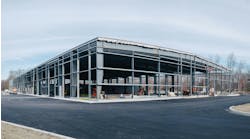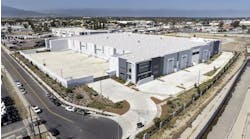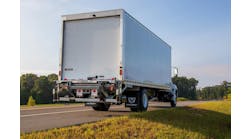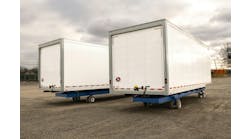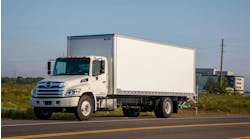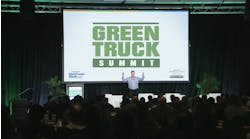The intent of this article is to make truck body and trailer manufacturers more familiar with recent advancements in chemical pretreatment and how they can enhance quality and reduce overall costs—including reductions of effluent issues.
Before we delve into the advancements in chemical pretreatment, let’s look into the issues that truck body and trailer manufacturers face in preparing their products for painting. These considerations fall into three general areas—the type of steel used, the type of material that must be removed from the steel before paint or powder coating is applied, and the process used to prepare the substrate.
Types of steel
Common substrates used in trailer and truck body manufacturing include:
Diamond plate is usually produced from hot rolled steel, but some manufacturers will use cold rolled steel. Diamond plate is not receptive to common pretreatment chemistry because of the scale produced in the hot-rolled manufacturing process.
HR and HRPO steel. Hot rolled steel contains scale. HRPO (hot rolled pickled and oiled) has had the scale removed and oiled to prevent rusting. HRPO is the most receptive substrate for chemical conversion. Like diamond plate, regular hot rolled steel is not receptive to common pretreatment chemistry because of the scale formed in the manufacturing process.
Cold-rolled steel is manufactured the same as HRPO. The metal is then passed through a series of rollers at room temperature to reduce the thickness, annealed and then rolled to remove any finishing marks. CRS has a better finish than HR/HRPO and is of a thinner gauge. CRS is more receptive to chemical conversion.
Aluminum, contrary to many beliefs, does corrode. It and produces “white” rust, unlike iron bearing substrates that produces “red” rust. Aluminum presents completely different issues than HR, HRPO and CRS when pretreated with traditional conversion chemistry, which will be explained further in the article.
Steels also vary by thickness and metallurgical properties. These differences cause them to react differently to common chemical pretreatments that truck body and trailer manufacturers typically use. In addition, welding creates a hardened area on the substrate, preventing common chemical conversion from occurring.
Because the chemistry does not fully convert the weldment areas, it’s not unusual to find pull back or “bridging” of the powder coating or paint. Welding also causes metal oxides to form, which are not well bonded to the surface. This oxide layer or scale must be removed prior to conversion coating.
The types of soils
Steels typically are covered with soils that must be removed before the surface can be coated.
Organic soils are any oil-bearing contaminant. They are sensitive to alkaline and/or surfactant-based chemistries. Examples of the type of soils encountered are mill oils (encountered on HRPO, CRS), coolants, cutting fluids as well as tube bending lubricants. These soils, dependent on the type of chemistry utilized, usually require a minimum of 120° F too be effectively removed. Organics must be removed for the chemical conversion process to occur.
Inorganic soils are those that are not alkaline sensitive. They react to acidic chemistry with a pH <7. Inorganic soils are scale (HR), shop and grinding dust. They are best removed through an acidic chemistry.
The above soils, as well as the dissimilar substrates, create challenges to the truck body and trailer manufacturers in choosing the correct chemistry and pretreatment process to achieve the highest degree of powder/paint adhesion and corrosion protection.
Types of pretreatment processes
Several processes are used to prepare metal for painting or coating. They include:
Hand wiping is not overly common in the industry. It involves wiping the completed trailer with solvents, typically MEK (methyl ethyl ketone), toluene or acetone. Paint is then applied to the substrate. Solvents, while cleaning the part, do not provide any corrosion protection and do nothing to enhance the adhesion of the top coat. Adhesion and corrosion protection aside, the use of these solvents is hazardous since they are flammable and may present noxious odors.
Spray wand application is a method for cleaning and applying a conversion chemical to the substrate via high pressure, usually 1000-1200 psi. The chemistry is applied manually and with traditional conversion chemistry at a temperature of 140-150°F. Spray wand pretreatment accounts for over 90% of finishing systems in the industry, due primarily to the size and configuration of the products manufactured. This process increases adhesion and corrosion protection when compared to hand wiping.
Though infinitely better than the preceding application, Spray wand pretreatment is not without drawbacks. Chemical is metered through the machine, usually at a concentration of 2-3%, although I have seen concentrations as high as 10%. The pH (critical in forming a conversion coating) cannot be controlled. At a pH below <4, a conversion coating will not be formed, and flash rusting may appear. At a pH above >6 and the same will occur as with a low pH.
The chemistry is most commonly a onetime application referred to as straight to drain. This presents an effluent issue since the typical type of chemistry utilized produces a high level of iron and phosphate, which goes into the local waste treatment system. Larger municipalities may be able to handle the waste stream. However, with restrictions being placed nationwide on phosphates, monitoring and surcharges are becoming more common.
An additional issue, and one that directly influences the quality of coating produced, is that of the operator. Since Spray wand application is manual, the operator needs to be trained in the correct method of chemical application. Another issue is that trailers and truck bodies are commonly treated in an enclosed environment. With temperature requirements of 140-150°F (for traditional conversion chemistry), that can be extremely uncomfortable for the operator.
Media blasting is becoming more common in the industry. The method, whether employing sand or metal, removes all soils from the substrates and profiles the metals prior to pretreatment. Media blasting promotes the best chemical conversion with the least amount of chemical pretreatment steps and chemistry required. But it also creates a very active substrate. Because the steel no longer has its protective coating of oil or scale, it is prone to rusting. It should be pretreated relatively quickly.
Advancements in pretreatment
Iron phosphate has traditionally been the conversion chemical of choice for spray wand application in the truck body and trailer manufacturing industry. Spray wand iron phosphate can be formulated to clean/coat (remove organics and convert the substrate(s) in a single step) or as a straight conversion chemical (no cleaning package). Simply explained, iron phosphate is formed by releasing iron (Fe) from the substrate, then redepositing it to form a non-reactive coating. This coating serves as a surface to which the powder or paint can more effectively adhere. It also serves as a barrier that protects against corrosion of the base metal.
The color produced with iron phosphate is normally bluish- grey, and is dependent on the accelerator used as well as pH value. In order for the conversion process to occur, the metal has to be heated, hence the need for 140-150°F temperature. Differing thickness of the substrates affect how the coating forms. Thinner gauge (CRS) will convert faster, creating “over deposition” also known as “powdering.” Thicker gauge material (HRPO) can suffer from “incomplete conversion,” adversely affecting short and long term adhesion.
An additional issue with iron phosphate is the fact that the chemistry cannot convert over scale (HR) or hardened metal, such as the weldment areas. The associated problem, commonly called “pull away” or “bridging”, is evident by incomplete coverage of the powder/paint. Remember, in order for the conversion process to occur, organics (oil) and inorganics (scale) must be removed. Dissimilar substrates, gauge thickness, and hardness each affects the ability to build a uniform coating.
Media blasting addresses the issue of oil and scale, allowing the chemistry to form over the dissimilar metals. But media blasting does not eliminate the issue of gauge thickness or hardened areas (weldments).
Aluminum presents completely different issues when preparing the substrate for top coating. Remember that in order for the conversion process to occur, iron must be present in the metal. Aluminum, dependent on the series used, contains little to no iron. Therefore, a conversion cannot take place with iron phosphate. What does happen, is that the aluminum is micro-etched, creating a “profile” for the top coat to adhere. However, iron phosphate offers no corrosion protection on aluminum, and the chemistry must be completely rinsed to remove the unreacted phosphate salts that will interfere with topcoat adhesion.
A big difference
Zirconium pretreatment is radically different from iron phosphate in numerous respects:
- It can be formulated to clean and coat in a single step.
- Zirconium has no effluent regulations and is more environmentally friendly.
- It handles differences in substrates and gauge thickness and is able to coat weldment areas, eliminating “bridging.”
- Zirconium operates at a lower temperature (80-110°F) and concentration (1-1.5%). It coats the substrate in less time (15-30 seconds vs 90 seconds with iron -phosphate) as well as offers higher corrosion protection.
- Zirconium is a non-regulated metal. It lays a coating on the substrate through an acidic medium, operates at a pH of 4.3-5.5 with a temperature requirement far below that of traditional iron phosphate, saving considerable energy cost and allowing a more “pleasant” environment for the operator.
Since zirconium does not require iron to be present in the substrate, it has the ability to “coat” dissimilar metals such as aluminum, as well as the hardened weld areas. This eliminates any non-converted area as well as “bridging”. Zirconium, unlike iron phosphate, produces a gold hue on the substrate. This is an adjustment for some people, because some people associate the goldish color with “flash rust” due to the experience they have had with traditional iron phosphate.
Production testing within the trailer and truck body industry has shown that zirconium attracts the charge of the powder more efficiently. This result reduces powder consumption without the decrease in millage applied. One truck body manufacturer documented a 50% reduction in powder consumed.
Is it right for you?
To determine if zirconium is a good choice for a particular application, compare it with traditional iron phosphate (salt spray, adhesion, impact) in controlled scenarios. Use your various substrates, not ACT or Q-Panels, which offer no relevance to the material you utilize on a production basis.
Have the testing done at an independent certified lab so as not to have any chance of impropriety, and do not rely upon your powder/paint supplier for recommendation on pretreatment alternatives. My thirty-years of experience has shown that their pretreatment chemistry knowledge is not as strong as one would like you to believe.
In summary
Zirconium has been widely accepted in the automotive industry, agricultural/off-road and general manufacturing as well as the Department of Defense, all of which have stringent requirements.
Zirconium pretreatment offers numerous benefits to trailer and truck body manufacturers. However, the industry needs to get over the “this is the way we have always done it” mentality. Above all, know your chemistry and system. Know what your chemical concentration is and your operating pH. Interview your chemical suppliers. Check their knowledge and manufacturing process. Do they formulate/manufacture their chemistry, or is it contract blended? What is their capability to support you on/off site now and in the future and are they proactive to your specific needs? Moreover, are they a “partner in quality” with you? ♦
___________________________________________________
Biography
Marc Oprean is employed in a technical capacity with EnviroServe Chemicals, Inc., Dunn, NC (www.enviroservechemicals.com). He has more than 30 years’ experience in the surface treatment of various substrates across North America. He can be reached at [email protected].
